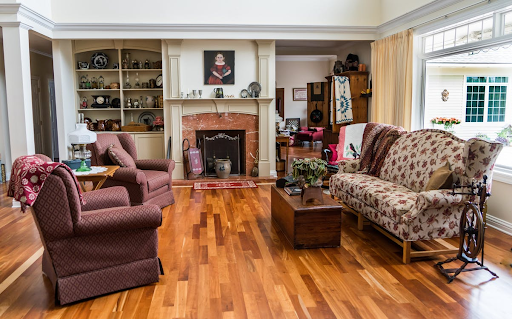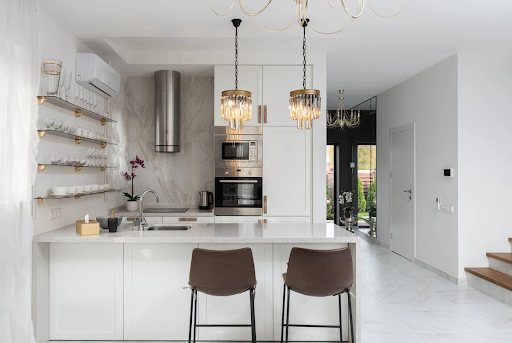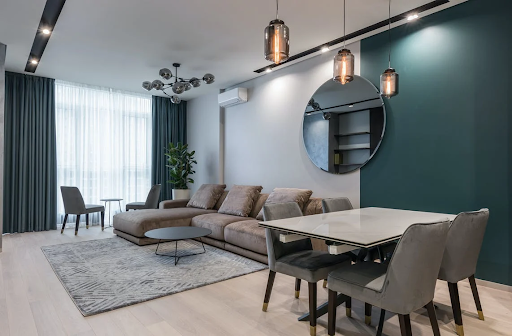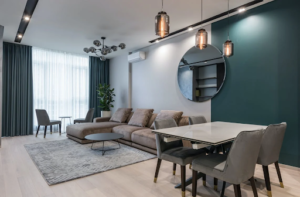Home staging is a home selling technique that helps buyers view homes and recognize if a specific home meets their needs. A 2021 survey found that 41% of prospective homebuyers were more likely to purchase a home after seeing an online walkthrough of the property.
Many home sellers furnish their property for showings to help demonstrate the home’s full potential for prospective buyers. This process has been taken a step further in the digital era in the form of virtual staging. Let’s examine the rise of virtual staging, its benefits, and how homeowners can use virtual staging to their advantage.
What is Virtual Staging?
Virtual staging is an innovative form of staging that allows homeowners to showcase the various rooms in their home using virtual furnishings. This means they can add furniture such as couches, tables, dressers, and chairs to otherwise unfurnished rooms virtually and showcase them to prospective buyers.
In advanced cases, homeowners may be able to make changes such as repainting walls or swapping out flooring virtually. However, these practices generally attempt to give prospective buyers an accurate representation of how the property could potentially look when furnished.
The practice of virtual staging emerged over a decade ago and has undergone many innovations. Modern virtual staging practices have advanced to the point where prospective home buyers are often unable to distinguish between virtually staged homes and real, staged ones. This makes virtual staging a powerful technique for homeowners who wish to show off their property’s full potential.
Today, homebuyers can look up homes and explore them virtually as easily as they would look up the best movie theater in Alexandria, VA, or old Alexandria seafood restaurants. This method for previewing homes has become incredibly popular and is routinely used by homeowners and realtors across the country.
Virtual Staging vs. Real Staging
Prospective home sellers who are unfamiliar with virtual staging should learn how it compares with real staging. Some of the key areas in which virtual staging is better than real staging are summarized below.
Pricing
Virtual staging’s most notable advantage over real staging is in price. One leading virtual staging services provider charges between $29 and $39 per photo. This means the average home will cost between $200 and $300 to virtually stage.
By contrast, real staging a home typically costs around $740 and $2,600. This amount is high due to the cost of renting furnishings, transporting them, and setting them up. For this reason, virtual staging can be up to 90% cheaper than real staging in many cases.
Turnaround Time
Virtual staging can be completed much faster than real staging. The latter is a multi-step process that involves selecting furniture in-person, completing paperwork, transportation, and setting up. This means the staging often takes between one to two weeks to complete, which may be troublesome for homeowners seeking to set up a showing on short notice.
Virtual staging can be completed much faster as the process generally involves obtaining high quality photographs and then altering them digitally. Many virtual staging services providers can complete staging within one or two days. This makes virtual staging an excellent option for homeowners who need to quickly put up a digital property listing.

Difficulty
Virtual staging is considered easier than real staging as most of this process is completed on a computer. The designer can start by uploading photos of each room for staging to their computer. They can then make changes such as adding furniture or changing wall colors. The designer can also run through different types of furniture until they find a combination that works well for the room.
This process is more difficult for real staging as the staging company will need to transport furniture to the home and set it up. If the furniture combination does not meet expectations, they will need to replace some or all the furniture items with different ones.
Real staging becomes incredibly challenging when significant changes such as wall repainting are required. By contrast, a designer can virtually repaint a wall in minutes using 3D design software.
Design Options
Virtual staging offers a greater number of design options compared to real staging. Real staging is often limited due to time and budget constraints. In addition to this, some types of furniture may be challenging to transport to the intended property for staging.
Staging companies must also ensure the type of furniture they wish to use for staging is available and has not been booked for another staging. Such limitations do not exist with virtual staging.
Designers and homeowners have the freedom to scroll through an infinite number of furniture options without worrying about constraints such as availability or transportation. They can also make digital alterations to floors and walls, which would not be possible with real staging in a limited timeframe.

Virtual Staging and Virtual Real Estate
Virtual staging has evolved to become a routine part of the selling process for virtual real estate. It can be used to create in-depth 360o home tours to help prospective buyers learn whether a specific home meets their needs.
Such tours are integral for buyers located in different cities or even other countries. Offering such tours allows homeowners to promote their property to a wide range of prospective buyers and boost their chances of making a sale.
How to Do Virtual Staging
Homeowners interested in virtually staging their home can choose between hiring professional virtual stagers or realtors who offer this service. Alternatively, they opt to perform this process themselves.
The following section describes how to do virtual staging effectively.
-
Take Photographs
The first step in the home staging process is to take photographs of each room you plan to stage. This process can be tricky depending on your photography knowledge and the type of cameras you have on hand.
Each photo should ideally be in the highest possible resolution to match the quality of the virtual furniture you will be adding. You should also activate your camera’s HDR setting if it has one. This setting helps ensure each section of the photo has the same and consistent exposure.
Homeowners should also turn on all the lights in the room and remove any decorations or furniture items that aren’t essential. Photos should also be taken from an angle or position that shows as much of the room as possible. Such photos are best taken from corners, so homeowners should aim to get two high quality photos from this position.
-
Select a Virtual Staging Software
Next, homeowners should download and install virtual staging software. Alternatively, they can choose an online service that offers these capabilities, such as PhotoUp. You can start using PhotoUp by visiting their website and creating an account.
-
Upload Your Photos
Homeowners who are using PhotoUp can then select the “Virtual Staging” option and upload their photos. They will then be presented with an option to select their room type. This includes choices such as:
- Living room
- Dining rooms
- Bedrooms
- Office
- Bathrooms
- Kitchen Sets
-
Select the Furniture
Next, homeowners can select the type of furniture they would like to include in their virtual stage. PhotoUp allows users to choose different furniture styles such as “Scandinavian” and “Hamptons” for this purpose.
-
Choose Export Settings
Users can then choose export settings for their photographs. This includes the option of exporting photos as “JPEG” or as “TIFF” files. Homeowners can then review their photos before submitting them for virtual staging.
How Michael Gailliot Homes Can Help
At Michael Gailliot Homes, we understand the importance of offering prospective homebuyers a high-quality preview of your property. We are familiar with virtual staging technology and techniques and aim to deliver a lifelike experience that offers an excellent representation of your home.
We believe virtual staging is the future of home staging and eliminates many of the challenges and drawbacks associated with real staging. Please get in touch with Michael Gailliot Homes to get your home virtually staged by experienced professionals who understand the ins and outs of selling homes.





